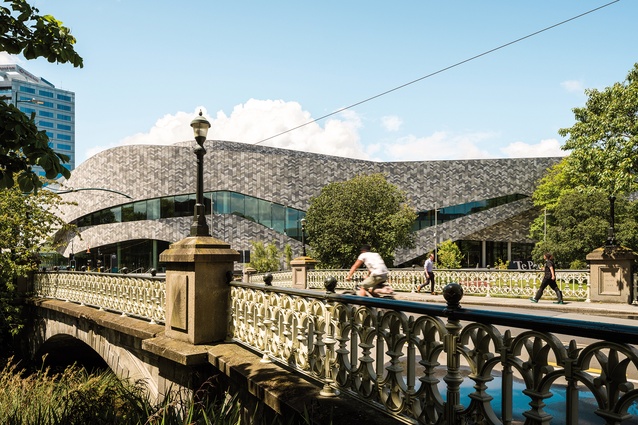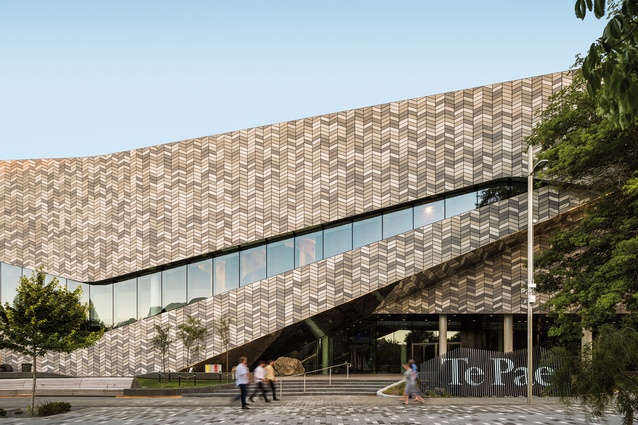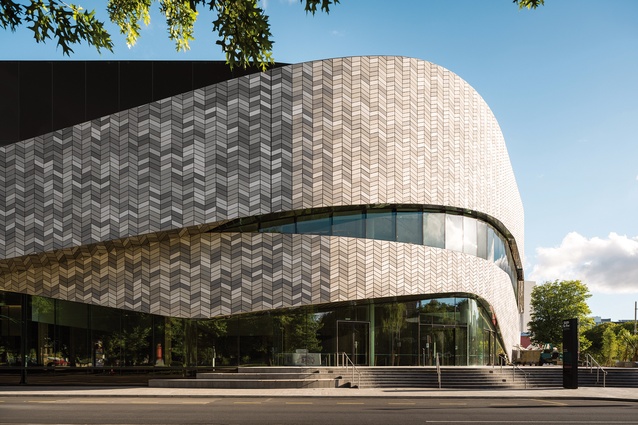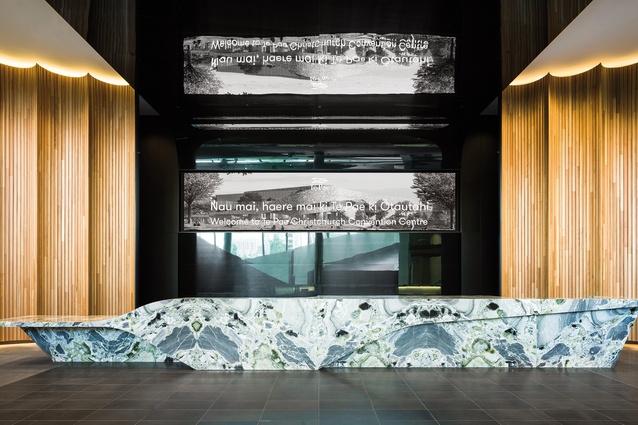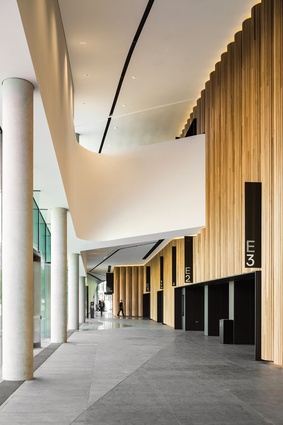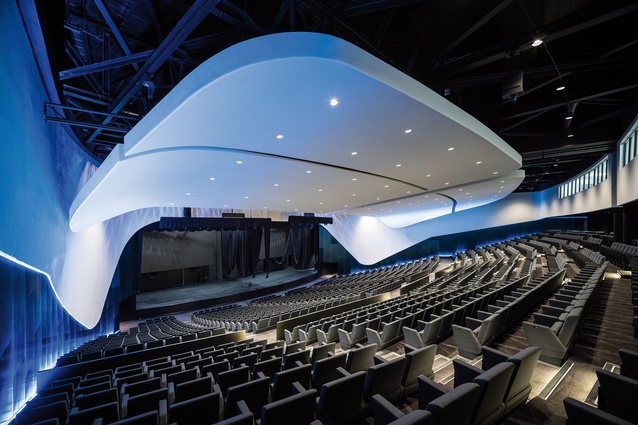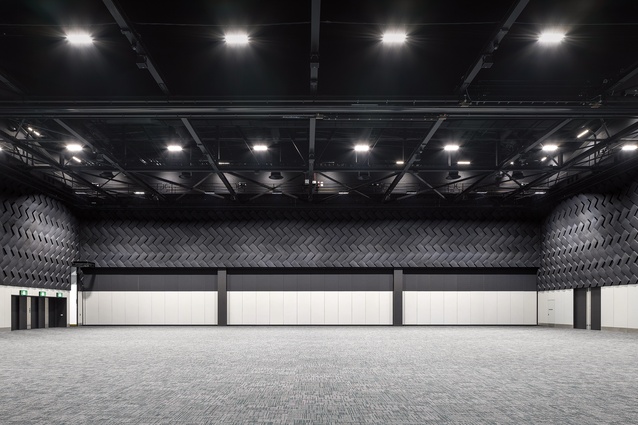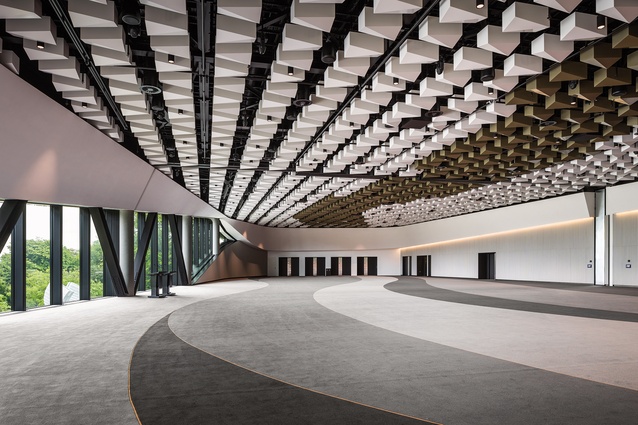River reflections
Ian Lochhead finds the massive form of Te Pae, Christchurch’s new $450-million convention centre by Woods Bagot in association with Warren and Mahoney, sitting somewhat uneasily amidst its still-crumbling colonial city landscape. But, from a distance, its sweeping, organic curves evoke ki uta ki tai, the interconnectedness of water, landscape and people, and the life-giving force of rivers flowing from mountains to sea.
The opening of Te Pae, the Christchurch Convention Centre, on 16 December 2021, auspiciously the 171st anniversary of the arrival of the first Canterbury Association settlers in Lyttelton, marks an important stage in Christchurch’s recovery from the earthquakes of a decade ago. Conceived as one of the anchor projects that formed part of the 2012 Christchurch Central Recovery Plan, or ‘Blueprint’ as it became known, the convention centre was intended to act as a major driver in the city’s recovery. However, the inevitable delays involved in planning and delivering such a large project mean that the promised, post-quake boost to the city’s economy has yet to be realised. In addition, the impact of Covid-19 has compounded these delays and raised questions about the viability of such venues in a warming, post-pandemic world.
Located in the heart of the central city, Te Pae sits across two former city blocks, bounded by The Square to the south, Victoria Square to the north and the Avon River to the west. Its eastern boundary is defined by the central city’s north-south spine of Colombo Street. The Blueprint treated the central city as a tabula rasa, the assumption being that few buildings from the pre-quake city either could, or indeed should, be retained. The prime site allocated to the convention centre formerly contained the city’s award-winning Central Library, a Warren and Mahoney design from 1982, along with a variety of buildings spanning the previous century of Christchurch’s development. With the exception of Helmore and Cotterill’s neo-Georgian, former Cook and Ross building (1927) on the north-east corner of the site, all these buildings were swept away, and the block of Gloucester Street between Colombo Street and Oxford Terrace was closed, one of several post-quake disruptions to the city’s street pattern.
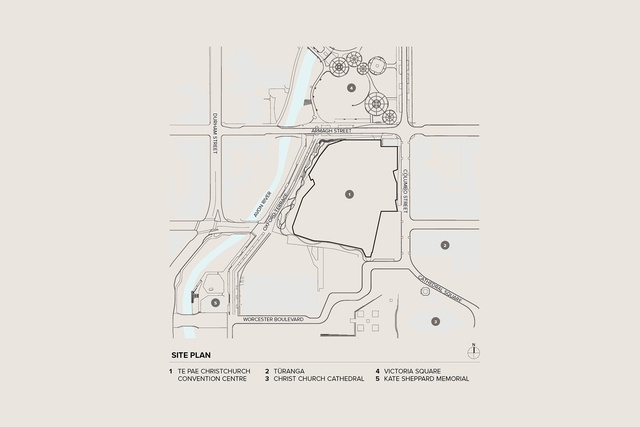
Early criticism of the location of such a large and, by definition, inward-focused building in such a prime location was countered by the promise that the design would incorporate an ‘active’ perimeter including retail and hospitality, However, like many of the promises made during the city’s recovery phase, this one evaporated in the trade-offs between aspirations and the costs of realising them. The possibility remains that some of these features will be realised as the empty sites between Te Pae and The Square and that on the eastern axis of Gloucester Street are developed by private landowners but this is far from certain.
In such a sensitive urban setting, the challenge for Woods Bagot was to make a very large, inward-looking structure responsive to its surroundings while meeting the expectations of the client for a convention centre capable of competing successfully in a global market. The solution was to push the client to reduce the size of the centre and to develop a distinctive identity for the building that would make it stand out when compared to routine, big-box convention centres. Unusually, the architects have posted a statement of their design intentions on the exterior of the building.
•Architects strive to ensure that major civic buildings reflect their contexts.
•The Te Pae Christchurch Convention Centre design team was inspired by this photograph of the Canterbury foothills taken by architect Bruno Mendes on a flight to Christchurch.
•The distinctive Canterbury braided rivers that flow from the Southern Alps are reflected in 43,000 speckled façade tiles that wrap around the contours of the building.
The sweeping, overlapping curves of Te Pae’s exterior, cut through by the free-form bands of windows, do indeed evoke the shingle fans and streams of the region’s rivers and the building’s cultural narrative, developed in conjunction with Ngāi Tūāhuriri. Central to this was the concept of ki uta ki tai, which emphasises the interconnectedness of water, landscape and people and the life-giving force of rivers as they flow from mountains to sea. The sweeping, organic curves of Te Pae’s exterior are also echoed in the surface patterns of paving and carpets throughout the building.

At a distance, the illusion of the river landscape is clear but, from closer up, it is disrupted by the insistent, geometric pattern of the tiles. Instead of an infinitely varied blend of colours and forms, the regular chevron pattern suggests repeated stacks of solid elements, creating an impression of folded planes rather than the flowing, smooth surface that was surely intended. Once this visual effect is recognised, it is impossible to ignore.
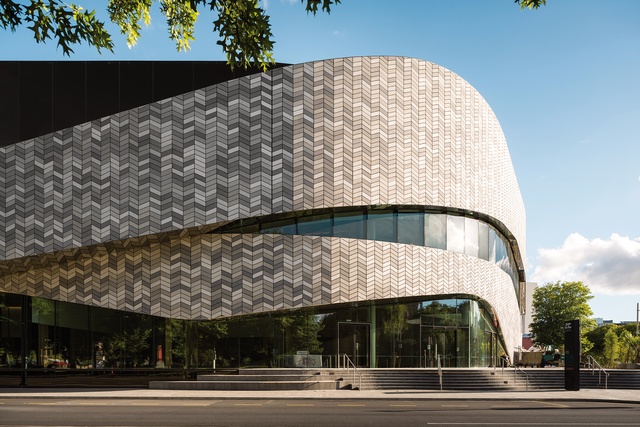
In responding to the wider Canterbury landscape, Woods Bagot has chosen to disregard Te Pae’s immediate architectural context: Mountfort’s Canterbury Provincial Council Buildings (1858–1865) immediately to the west, and Warren and Mahoney’s Christchurch Town Hall (1966–1972) on the north side of Victoria Square. In marked contrast to Te Pae, where the differing internal spaces are wrapped in an all-enveloping skin, these earlier buildings express their component parts as clearly legible external elements.
Te Pae’s main entrance is from the west. Here, the building and the Avon River margin are treated as a single entity, with the landscaping extending seamlessly to the river’s edge. Generous circulation spaces can be glimpsed through the dark-tinted glass of the perimeter walls. To the left of the entrance, three large boulders, recovered from the Port Hills following the earthquakes, speak to the cataclysmic events that lie behind the building’s origin. Serendipitously, they are reflected in the polished steel of the sloping soffit immediately above. Reflection also plays a part in the main entrance foyer, where the polished blue steel of the ceiling creates the impression of a double-height space. To the south, the foyer expands to provide access to the main exhibition hall but it is also large enough to double as an event space in its own right. The inner walls throughout the ground floor are clad in undulating, fluted panels of blackbutt (eucalyptus pilularis); these create a feeling of warmth and, by reflecting and absorbing sound, they dampen the acoustic of what would otherwise be a highly reverberant space.

The heart of Te Pae is the 3000m² exhibition hall. The scope for adding architectural interest to such a large, undifferentiated space is inevitably limited but moveable walls contribute to the flexibility of the design. The space can be subdivided in multiple configurations and it also has facilities to support its use for large banquets.
To the north of the reception area, the circulation space is more constricted. A series of smaller, ground-floor meeting rooms extends along the northern margin of the building while escalators and stairs lead to the upper-level foyer of the plenary hall. This 1400-seat auditorium incorporates the sweeping lines of the exterior and is arranged in a single rake of seats. The absence of a balcony enhances the sense of a non-hierarchical, unified space. It also makes it possible to increase the flexibility of the auditorium, since a retractable wall on the axis of the central aisle allows the room to be physically and acoustically subdivided into two 700-seat auditoria.
The foyer of the auditorium leads into the main banquet hall at the southwest corner of the building. This is another vast space, capable of seating up to 1000 diners. Its sweeping form follows the underlying design theme while its curving windows take full advantage of its western aspect. The effectiveness of this space, like that of others throughout the complex, is hard to judge while the building is empty; the true measure of all these interiors will come when Te Pae is thronging with conference-goers.

For conference delegates and visitors to the building, these public spaces are the ones that matter; for exhibitors and staff, the eastern side of the complex is equally critical. The boundary between the public zone and back of house is defined by the loading dock, which is entered from Armagh Street at the north-east corner of the building. This is effectively a covered lane through the site with its exit to Colombo Street at the building’s south-east corner. This allows direct access to both the stage of the plenary hall and the main exhibition space and should allow for efficient packing in and out of exhibits. At street level, both entrance and exit are surprisingly discreet.
Administration facilities are concentrated along the Colombo Street margin of the complex, opposite the area designated as the cultural precinct in the city’s regeneration Blueprint. The black, reflective glass treatment of this façade perpetuates a standard office typology but seems unnecessarily austere in this location.
Te Pae’s interface with The Square along its southern boundary is also, for the time being, unresolved. Historically, the cruciform edge of The Square has been carefully maintained but post-quake demolitions have eroded this defining boundary. It remains to be seen whether or not the sites currently awaiting redevelopment will reinstate this formal relationship between Christchurch’s most significant public space and its built edge. Te Pae projects into The Square at this point, its southeast entry extending outwards and upwards to draw visitors in. How this entrance will engage with the rebuilt fabric of The Square’s edge remains an urban design challenge for the future.
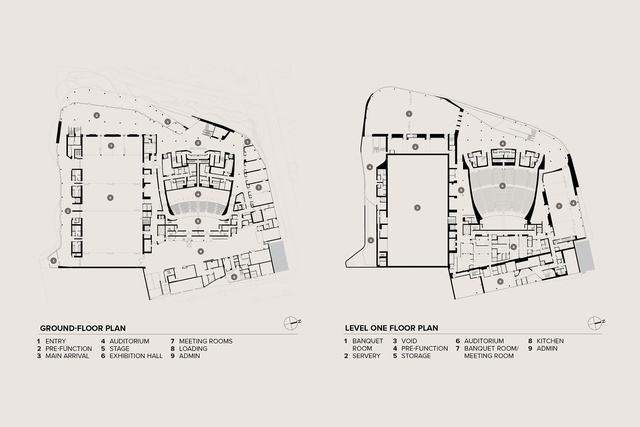
The completion of Te Pae marks a further stage in Christchurch’s slow return to something like normality. Its cost of $450 million is a significant government contribution to the city’s revival but it throws into relief the remarkable value of the strengthened and restored Christchurch Town Hall at $167 million. Furthermore, it directs a spotlight on the failure of both central and local government to grapple with the restoration and reconstruction of the Provincial Council Buildings directly opposite. For how long will 21st-century visitors from around the world, like Macaulay’s mythical New Zealander reflecting on the ruins of the empire from London Bridge, look out from Te Pae and contemplate the crumbling ruins of Canterbury’s colonial aspirations?

